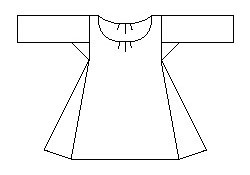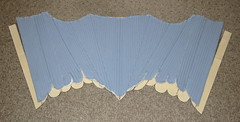After a bit of experimentation, I've found a basic chemise design that's comfortable, simple to make, and works well with the majority of my historical wardrobe (that being clothes from 15th c. northwest Europe). If I venture to other times and places, I may need a different style of underwear, but when I just need a new chemise it's usually a copy of this one.
I use a simple geometric cut that's based on earlier tunic styles. While outerwear in this time uses increasingly complex tailoring, the rare depictions of chemises in art suggest that it continued to be a simple, loose garment. The main body panel is a large rectangle, folded over at the shoulder, with overall width slightly larger than half the bust measurement. Normally, this would produce a shoulder seam that falls down the arm, but pleats at center front and center back in the neckline pull the width together so that the shoulder seam falls on or near the natural shoulder. The sleeves are also rectangular, forming an untapered tube, with a square underarm gusset. Triangular gores in the side seams fill out the width of the chemise, with overall length being below knee to mid-calf. The neckline generally follows that of the gown it is to be worn under; mine typically have a low scoop neck, matching my 15th c. kirtles. I typically use 3-4 small box pleats at center front and center back in the neckline, but that is adjusted based on fit as I am finishing the garment.
For construction, nothing I have found beats lightweight linen, the lighter weight and finer weave, the better. I start assembly by sewing each sleeve to its gusset, then down the arm. Once each sleeve is assembled, I match the top of the sleeves to the shoulder point (mid-point on the length) of the body panel, and work down in both directions until the seams meet at the bottom of the gussets. Then I attach a gore to each side, front and back, and finally sew the side seams between the gores. Cutting the neckline is more an art than a science - start with the smallest hole that fits over your head and gradually trim away. The front needs to be lower (frequently a lot lower) than the back. The shape I end up with before I put in the pleats is a rectangle with rounded corners - there's a flat edge in front and back that will be taken up by the pleats, and a short straight section on the sides right where it hits the shoulder line. I finish the neckline with a single fold, and cover the raw edge on the inside with a length of 1/4 inch linen tape, sewn down with two rows of running stitch. This produces a very stable, neat neckline that won't roll or stretch out of shape.
20 November 2007
09 November 2007
18th c. strapless stays: fully boned
I've finally finished getting all the boning in and the ends trimmed to the right lengths on my strapless stays. My channels ended up being a bit narrow, so it was more work than in should have been, I think. Anyway, it's 1/4" half-round reed; two per channel with flat sides together. I do definitely like the lightness of the reed - even as a completely boned garment, it doesn't seem too heavy.
My biggest problem at this point is one of size and fit. In the photo, the stays are laying on top of the mock-up used to create the pattern pieces. And it's 2+ inches smaller horizontally (vertical is more or less unchanged). This turns a quite reasonable 2 inch gap for lacing into more like a 5 inch gap, with the dips for my arms being too far forward. I've double-checked my pattern pieces and my unassembled lining against my mock-up, and they're all the right size and include the proper seam allowances. So most or all of this difference is due the the shrinkage from inserting the boning.
So long story short, these stays are nearing completion and it doesn't look like they'll fit me. My plan at this point is to go ahead and put eyelets in and try to wear it as-is, which will hopefully stretch things out again. If not, I'll be thinking about replacing the two center front sections with much larger ones. Either that, or find a very petite lady doing 18th c. reenactment who'd be interested in buying them.
My biggest problem at this point is one of size and fit. In the photo, the stays are laying on top of the mock-up used to create the pattern pieces. And it's 2+ inches smaller horizontally (vertical is more or less unchanged). This turns a quite reasonable 2 inch gap for lacing into more like a 5 inch gap, with the dips for my arms being too far forward. I've double-checked my pattern pieces and my unassembled lining against my mock-up, and they're all the right size and include the proper seam allowances. So most or all of this difference is due the the shrinkage from inserting the boning.
So long story short, these stays are nearing completion and it doesn't look like they'll fit me. My plan at this point is to go ahead and put eyelets in and try to wear it as-is, which will hopefully stretch things out again. If not, I'll be thinking about replacing the two center front sections with much larger ones. Either that, or find a very petite lady doing 18th c. reenactment who'd be interested in buying them.
02 November 2007
Slow season
For me, fall is a bit of a slow season for sewing (as is showing in the lack of activity here). I've finished with last season's projects, and done the mending for the clothes that got worn a lot during the warmer months. But I haven't yet geared up for any big winter projects. This year, I've also been busier than usual with work, which slows things down even more. But I have gotten a few things done in the six weeks since my last post. From the pile of UFOs (UnFinished Objects), I finally put all the buttons and buttonholes on my schaube from last year. I've got reed into all the channels for my 18th c. stays, and I'm currently working on trimming them down to exactly the right size in order to bind the edges. I'm a bit worried about the fit on that project, though, as it seems to be turning out quite noticeably smaller than my mock-up. I've a also started a new project; I made a quick muslin for a new gown I'd like to get done for Twelfth Night. On the fiber arts side, I bought a ball winder and a swift, mostly for use with my spinning. I've also been working (very slowly) to clean and deal with accumulated clutter in my sewing room. This is a major quality of life issue as far as being able to work on projects, as my actual space for doing stuff was disappearing at an alarming rate. Hopefully I'll soon have more done in the way of 'visible' progress.
Subscribe to:
Posts (Atom)

